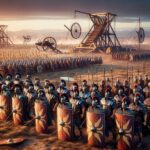A Queen’s Defiance: Boudica’s Uprising Against Roman Rule
You’ve likely heard whispers of Boudica, the warrior queen of the Iceni people. She’s a legend, a symbol of defiance etched into the very heart of British history. But her story, etched in the flames of rebellion, is far more than just a tale of battles won and lost. It’s a story of injustice, of a queen’s unyielding love for her people, and a fight for freedom that still echoes centuries later.
Journey back to ancient Britain, a land struggling under the heavy hand of Roman rule. The Iceni, known for their fierce independence, were no strangers to conflict. But when their beloved king, Prasutagus, died in 60 CE, the Romans saw an opportunity – a chance to tighten their grip on the Iceni lands and people.
What followed was a grave miscalculation. Disregarding Prasutagus’s will, a document meant to ensure his family and kingdom remained untouched, Roman officials, drunk on power, seized Iceni lands. Adding insult to injury, they publicly flogged Boudica, the rightful queen, and violated her daughters. This wasn’t just a power grab; it was a brutal, calculated act of humiliation.
Rome, however, underestimated the spirit of Boudica and the simmering rage of the Iceni people. Fueled by fury and grief, Boudica ignited a firestorm of rebellion. Tribes who had long endured Roman oppression flocked to her banner, united by a shared thirst for justice.
Their first target? Camulodunum (modern-day Colchester), a symbol of Roman arrogance built upon stolen Iceni land. The rebels stormed the city, tearing it down stone by stone. Londinium (London), a bustling Roman trading hub, met a similar fate. Then came Verulamium (St. Albans), another Roman settlement, which also fell before the Iceni’s wrath. With each victory, Boudica’s legend grew, a beacon of hope against the seemingly invincible Roman war machine.
The tide, however, began to turn. The Romans, masters of warfare, regrouped under the ruthless Gaius Suetonius Paulinus. He lured Boudica’s forces into a final, devastating battle. Though the exact location remains a subject of debate, the outcome was a resounding Roman victory. Outnumbered and outmaneuvered, the rebellion was crushed, its fire extinguished in a bloodbath.
The fate of Boudica herself remains shrouded in mystery. Some historians suggest she took her own life, refusing to become a Roman trophy. Others believe she succumbed to illness, her spirit unbroken despite the crushing defeat.
Boudica’s Enduring Legacy: A Symbol of Resistance
Though the rebellion was ultimately unsuccessful, Boudica’s impact on history is undeniable. She became a legend, a symbol of resistance against tyranny that continues to inspire to this day. Her story serves as a stark reminder: that even in the face of insurmountable odds, the human spirit, fueled by the fight for freedom and justice, can shake empires to their core.
Even today, archaeologists are uncovering new pieces of this historical puzzle, adding depth and detail to our understanding of Boudica’s rebellion. Every artifact, every inscription, brings us a step closer to understanding the true brilliance of her military tactics and the sheer scale of the Roman response.
But it’s not just about digging up the past. Boudica’s tale lives on in art, literature, and popular culture. From statues to paintings, poems to plays, her image has transcended time, a testament to the power of her story to resonate across generations.
Boudica’s story is not just a dusty chapter in a history book. It is a timeless reminder that the fight for freedom is never truly over, and that even in defeat, courage and defiance can leave an enduring mark on history.
Boudica or Boadicea: Unraveling the Mystery of a Name
So, you’re curious about the warrior queen, Boudica, right? You might have also seen her name spelled as Boadicea. This often trips people up, but it’s actually pretty simple: they both refer to the same powerful woman who stood up to the Roman Empire.
Think of it like this: imagine your name is Katherine, but sometimes people call you Kathy. They’re both you, just spelled differently.
In Boudica’s case, “Boudica” is closer to how her name would have been pronounced in the old Celtic language, Brythonic. It means “victorious woman,” which totally fits her reputation! “Boadicea,” on the other hand, likely emerged later due to a mistake when copying old texts.
Even though “Boadicea” was possibly a result of an error, it caught on, especially during the Victorian era in England.
So, while both spellings are used today, historians and scholars tend to prefer “Boudica.” It’s considered the more accurate representation of her name.
The Fate of the Iceni: Life After the Rebellion
Boudica’s rebellion was a blaze of glory, a defiant stand against the might of Rome. But what happened after the flames died down? For the Iceni, the aftermath of the rebellion was a time of profound hardship. Imagine having your homeland, your traditions, your whole way of life ripped away. That’s what they faced.
Archaeological evidence suggests that many Iceni simply vanished from their old territories after the rebellion. It’s likely they were forced out by the Romans, their homes and fields seized as spoils of war.
The Iceni, once proud and independent, were now subjects of Rome. They had to abandon their old ways, bit by bit, adopting Roman customs – their laws, their language, even their clothes. It’s a classic example of how a conquering force can slowly absorb the people they conquer, until the original culture fades away.
The exact fate of every Iceni remains unknown. Records from that time are patchy at best. Some may have clung to their old beliefs in secret, passing them down through whispers and stories. Others may have fully embraced the Roman way of life and blended into the new society.
The Roman Adversary: Gaius Suetonius Paulinus
The Iceni tribe, led by Boudica, shook the foundations of Roman rule in Britain. But who was the Roman governor tasked with facing this unprecedented uprising? The answer: Gaius Suetonius Paulinus.
Paulinus was a seasoned and ruthless general, known for his brutal efficiency in crushing rebellions. When the Iceni revolt erupted, he was occupied with a campaign against the Druids on the island of Mona (modern-day Anglesey).
Recognizing the severity of the Iceni rebellion, Paulinus abandoned his campaign in Mona and marched his legions south. What followed was a clash of titans, a decisive battle where Paulinus’s tactical brilliance and disciplined Roman legions faced off against Boudica’s sheer determination and the raw fury of the Iceni warriors. While the exact location of this pivotal battle remains a subject of debate among historians, the result was a crushing Roman victory.
The aftermath of the battle saw Paulinus implement a period of harsh repression, a calculated campaign to extinguish any remaining embers of rebellion and ensure the Iceni wouldn’t dare to challenge Roman might again. His actions cemented his legacy as a key figure in the suppression of the Iceni rebellion.
Digging Deeper: Uncovering the Untold Story
The story of Boudica and the Iceni rebellion is far from a closed book. Here are some avenues for further exploration:
- Beyond Roman Accounts: Most of what we know about Boudica comes from Roman historians like Tacitus. Exploring the perspectives of the Iceni and other British tribes, though challenging, could offer invaluable insights.
- Women and Power in Ancient Britain: Boudica’s role as a female leader in a male-dominated society is fascinating. How did her gender shape perceptions of her actions, both by her contemporaries and by later historians?
- The Archaeology of the Revolt: Ongoing archaeological discoveries continue to shed new light on the rebellion. Analyzing destruction layers at Roman sites like Camulodunum, Londinium, and Verulamium can offer tangible evidence of the conflict’s intensity.
- Boudica in Modern Culture: Boudica’s image has been used and reinterpreted in art, literature, and popular culture for centuries. Analyzing these representations can reveal how her story continues to resonate with modern audiences.
The more we learn, the more nuanced and complex the story of Boudica and the Iceni rebellion becomes. It’s a story of courage, defiance, and the enduring human spirit in the face of oppression – a story that continues to captivate and inspire us centuries later.
If you are curious about more pictures of the great pyramid of khufu, you can find some here.
The Roman god Cupid had a Greek counterpart, and you can read about that here.
- Unlock 6000+ words beginning with he: A comprehensive analysis - April 20, 2025
- Mastering -al Words: A Complete Guide - April 20, 2025
- Master Scrabble: High-Scoring BAR Words Now - April 20, 2025

















1 thought on “Boudica and the Iceni Rebellion: The Untold Story of Britain’s Warrior Queen”
Comments are closed.